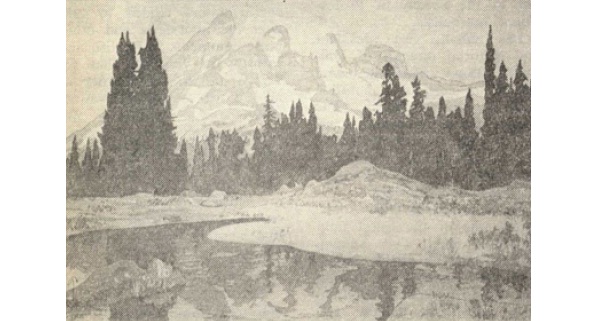by Fred Harris
Hiroshi Yoshida
I first came upon Hiroshi Yoshida’s prints in the small shop run by the late Akimasa Nakazawa opposite the Imperial Hotel in the early 1950s. They seemed like prints made from sweet-looking water colors at the time and, as my attention was directed to the stylized landscapes of Hokusai and Hiroshige, I didn’t give Yoshida’s prints that much thought. I remember they were not very expensive, selling for the equivalent of $10 or so at that time.
It wasn’t until I started to paint the Japanese landscape myself that I realized just how much sensitivity and quality were contained in Yoshida’s prints.
Yoshida was born in Kyushu in 1876. His talent for art was discovered at a very early age when he was in junior high school. At the age of 17 he was soon moved to Kyoto where he began studies in oil painting. A gallery in Yokohama started to handle young Yoshida, and it was fortunate they were seen by Charles H. Freer, wealthy collector of Oriental art and patron of Whistler. Freer asked to meet Yoshida, and the latter was encouraged to visit the United States where Freer would arrange for his work to be shown at the Detroit Art Gallery.
This fortunate meeting and arrangement started Yoshida on an odyssey which was the first of many journeys he would take in the course of his life.
Together with an artist friend, he set sail for the United States. The exhibition was held in Detroit, entitled “Water Color Paintings by Japanese Painters.” From there the two young men exhibited at the Boston Art Museum and elsewhere. The paintings sold well and provided enough money to permit them to tour the major cities of Europe, before returning to Boston late in 1900.
In 1903 Yoshida was to go abroad again, studying, sketching and exhibiting. America, Europe and North Africa were his inspiration. He brought back to Japan exotic pictures of the Alhambra. the pyramids and Swiss Alps. Eventually he became the most popular Western-slyle painter in Japan.
In 1920 when Yoshida was 44 years old he was commissioned to produce a woodblock print of the Meiji Shrine, This was done in collaboration with the Watanabe woodblock company who soon produced seven more designs in woodblock after the water colors of Yoshida. It must be understood that Watanabe was a professional publisher of prints who had printers and carvers working for him. Yoshida at that time didn’t do the production work himself. However this situation was not to last very long and Yoshida became personally skilled as a carver and printer believing that those who rely on the skills of others must be able to surpass them.
The disaster of the 1923 earthquake was to have a dramatic change in the life of Yoshida. He immediately went to the United States to sell his pictures to raise money for the needy. Returning to Japan in 1925, he decided to start publishing his own pictures. The sales of his oil paintings financed this venture and gave him the freedom to experiment and publish prints that might be otherwise considered uneconomical. In the next 20 years Yoshida published more than 240 prints.
In 1939 Yoshida published a book in Japan but written in English called “Japanese Wood Block Printing.” This volume helped spread the popularity that the modern print was starting to have. As a special feature the book included the number of blocks carved and the number of separate impressions needed to produce each of 220 prints. Some prints required 60 impressions from 14 blocks. His “Hirosaki Castle” (which I own) required 51 impressions from 11 blocks.
Yoshida Hiroshi’s prints today are very expensive. The usual auction catalogue from Sotheby’s or Butterfield’s list his prints for large price estimates. Luckily for me I tuned into the Yoshida print charm about 10 years ago and now have about 15 of them.









